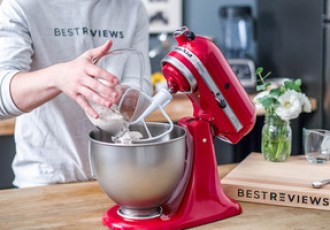We recommend these products based on an intensive research process that's designed to cut through the noise and find the top products in this space. Guided by experts, we spend hours looking into the factors that matter, to bring you these selections.

Whether you’re baking a cake or whipping up a family dinner, most U.S. recipes measure ingredients in cups. Therefore, every kitchen needs a measuring cup set.
Since you may be using it daily, finding a high-quality set is worth it. To the untrained eye, all measuring cup sets may look the same. In fact, the quality and price range is wide. With so many options available, how do you find the right set for your kitchen?

Basic measuring cup sets contain four individual measuring cups: 1/4 cup, 1/3 cup, 1/2 cup, and 1 cup. Larger sets may also contain 1/16 cup, 1/8 cup, 2/3 cup, and 3/4 cup.
Many measuring cup sets include measuring spoons. The basic measuring spoons are 1/4 teaspoon, 1/2 teaspoon, 1 teaspoon, and 1 tablespoon.
Some sets may contain more, including 1/16 teaspoon, 1/8 teaspoon, 3/4 teaspoon, and 1/2 tablespoon.
Most measuring cup sets have a nesting design — the smaller cups stack inside the larger ones.
Some silicone models fold down, which further saves space, but splits can develop over time in the creases.

Usually, measuring cup sets are made from either plastic or stainless steel.
In general, stainless steel is preferable as it’s stronger and more durable than plastic. Stainless steel doesn’t become tainted with the scents and flavors of strong ingredients either.
Silicone measuring cups are another option, but they’re not the most durable choice.
You can find ceramic measuring cup sets, too. Though attractive, they aren’t the most practical option. They’re fragile and likely to break if dropped.

Ideally, measuring cups should have sturdy handles, so they don’t bend when you scoop out ingredients.
Long handles make it easier to scoop an ingredient from the bottom of a bag, but they can be more likely to bend.
Find a measuring cup set with a happy medium between length and strength.
Some measuring cups have additional measurement markings on the side, so you can use a bigger cup to measure smaller amounts of ingredients. For instance, a 1-cup measuring cup might have 1/4 cup, 1/2 cup, and 3/4 cup measurements marked on it.
This is convenient, since it means you only need to use one cup to measure different volumes of different ingredients.
However, this method is likely to be less precise than using the appropriate measuring cups, so it’s best to avoid using one cup for recipes that must be exact.
Measuring cup sets are functional items and most have a standard design.
That said, you can find measuring cup sets with novelty or themed designs, like cups designed to look like cats or a stackable beehive.
Measuring cup sets with more intricate designs are usually made from ceramic.
While measuring cup sets shouldn’t break the bank, it’s worth investing in a durable high-end set if you often cook from recipes.
A basic measuring cup set costs $5 to $10.
These can be plastic or metal, but metal sets in this price range tend to be flimsy. Inexpensive sets usually contain four measuring cups and no measuring spoons.
A mid-range measuring cup set costs $10 to $20.
In this price range, sets come with both measuring cups and measuring spoons.
A high-end measuring cup set costs $20 to $50.
At the top end of this price range are ceramic sets with novelty designs, which may be attractive but aren’t necessarily practical. At the low end of this price range are high-quality stainless steel sets that will stand up to years of daily use.
Cups are standardized measurements, so you can’t use any old mug or cup from your cupboard. You need a proper set of measuring cups to get consistent results.
If you pour or scoop out too much of an ingredient, leaving you with a heaped measuring cup, level off the excess with the back of a knife.
When measuring flour, you usually don’t have to sift it unless the recipe explicitly calls for sifting before measuring. Modern flour doesn’t tend to be lumpy, so it only needs a quick stir before adding other dry ingredients.
When measuring brown sugar, pack it into the cup. This is the standard way to measure brown sugar.

A. Standard measuring cups are designed for measuring dry ingredients. Liquids have different volume measurements, so there are measuring cups specifically for liquids. That said, unless you’re baking or making a recipe that has to be extremely precise, you can usually get away with using dry measuring cups to measure liquids.
A. The majority of standard stainless steel and plastic measuring cups are dishwasher-safe, but this can vary, so check the manufacturer's specifications.
A. In case you need to do conversions from other volume measurements into cups, it’s useful to know that 1 cup equals 8 fluid ounces or half a pint.
Get emails you’ll love.
Learn about the products you’re wondering if you should buy and get advice on using your latest purchases.
